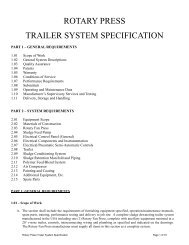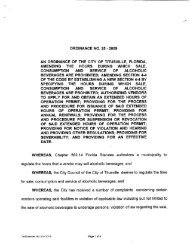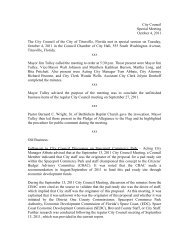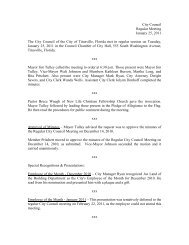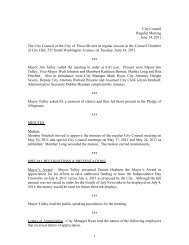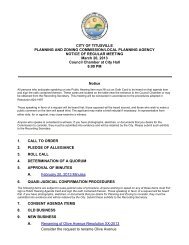annual report-2008.pdf - The City of Titusville, Florida
annual report-2008.pdf - The City of Titusville, Florida
annual report-2008.pdf - The City of Titusville, Florida
Create successful ePaper yourself
Turn your PDF publications into a flip-book with our unique Google optimized e-Paper software.
ANNUAL REPORT—2008TITUSVILLEFire and Emergency ServicesDepartment
Motto: Service doesn’t come from amanual—it comes from the heart.As <strong>Titusville</strong> Fire and Emergency Services Fire Chief, it is with great pride that I present ourdepartment’s 2008 Annual Report. This <strong>report</strong> provides an overview <strong>of</strong> the services that yourfire department provides and identifies our accomplishments over the past year. It is ourhope that this <strong>report</strong> helps our community better understand the various responsibilities andactivities that we are challenged with every day in protecting you and your property from “allhazards” that can affect your quality <strong>of</strong> life.This past year presented many challenges, particularly Amendment 1, which resulted in theloss <strong>of</strong> a few key positions within the department. As our calls for service continue toincrease and revenue sources continue to decline, it is becoming increasingly more difficult tomanage our budgets to the bottom line while providing for the safety <strong>of</strong> both our personneland our citizens. We will continue to do the best we can to serve you with the resources withwhich we are provided.One <strong>of</strong> the ways we continue to provide some <strong>of</strong> our services is through the assistance <strong>of</strong> ourcommunity partners. Due to their support we have been able to take proactive measures atno cost to the public, to better ensure our community’s safety by providing injury prevention,fire prevention, child safety seat installation, and CPR classes. We also provide vials <strong>of</strong> life,bicycle helmets, and carbon monoxide and smoke detector installations.Our department volunteer program also assists the department in meeting many <strong>of</strong> our day today <strong>of</strong>fice activities. Without their contributions, we would not be able to do what we do in fireheadquarters. Our fire prevention division does a wonderful job <strong>of</strong> ensuring our businesscommunity remains vigilant in their fire safety practices and that new constructing meets allfire codes—codes that protect both our fire fighters and our citizens from the detrimental impacts<strong>of</strong> a fire.None <strong>of</strong> the accomplishments in this <strong>report</strong> could be obtained without the dedicated men andwomen in our department who daily perform to the best <strong>of</strong> their abilities and put themselves inharms way while protecting you, your families and your property. It is my honor and privilegeto lead this department and it is my fervent hope that you will never need our services.However, in the event you ever do need us we will make your situation better by the serviceswe provide.In your service,Charles R. BogleFire ChiefPost Office Box 2806 <strong>Titusville</strong>, FL 32781-2806 (321) 383-5708 www.titusville.com
VISION STATEMENT<strong>Titusville</strong> Fire and Emergency Services Departmentshall be the leading provider <strong>of</strong> emergency servicesin the community it serves.MISSION STATEMENT<strong>The</strong> mission <strong>of</strong> the <strong>Titusville</strong> Fire and EmergencyServices Department is to provide the community withemergency services by highly trained, pr<strong>of</strong>essional personnelin an expedient and effective manner. Furthermore, it is ourduty to protect and promote the health, safety and overallwell being <strong>of</strong> the community we serve.Our commitment is to:GUIDING PRINCIPLES• Promote teamwork• Respect others• Be open-minded• Be progressive and responsive to change• Encourage input• Foster a positive and safe work environment• Encourage and recognize initiative and creativity• Set goals and achieve results
FireChiefFireChaplain(Volunteer)AdministrativeSecretary(Temporary)Division Chief<strong>of</strong> OperationsDivision Chief <strong>of</strong>AdministrationClericalAssistant IISecretaryCommunityVolunteersLogistics SpecialistEMS/TrainingChiefBattalionChief(3)Station 10Lieutenants (3)Driver-Ops. (3)Firefighters (3)Station 11Lieutenants (3)Driver-Ops. (3)Firefighters (4)Station 12Lieutenants (3)Driver-Ops. (3)Firefighters (4)Station 13Lieutenants (3)Driver-Ops. (3)Firefighters (3)Senior InspectorInspector I(Contractual)Life SafetySpecialistClericalAssistant I(P/T)1
Executive leadership <strong>of</strong> the Fire and Emergency Services Department is the responsibility <strong>of</strong> the FireChief. Visioning, planning, managing and successfully positioning the department to meet the currentand future emergency needs <strong>of</strong> our community are vital functions <strong>of</strong> this position.Fire Chief Charles R. BogleFire Chief Chuck Bogle joined <strong>Titusville</strong> Fire and Emergency Services as afirefighter in 1986, promoting through the positions <strong>of</strong> Lieutenant, BattalionLieutenant and Acting Operations Chief. He achieved the rank <strong>of</strong> DivisionChief/Fire Marshal, overseeing the fire inspection and the public educationsections <strong>of</strong> the department. As division chief, he also served as thedepartment’s Financial Manager, monitoring the expenditures <strong>of</strong> the departmentand assisting with long range budget forecasting. As division chief, he servedas the second-in-command <strong>of</strong> the Fire and Emergency Services Department.At the request <strong>of</strong> the <strong>City</strong> Manager, he assumed the position <strong>of</strong> CommunityDevelopment Director in mid-2005, overseeing the functions and activities <strong>of</strong> the Building, Planning,Engineering, Economic Development and Neighborhood Services divisions. He served in this capacityfor 2 years before accepting the position <strong>of</strong> Fire Chief in November <strong>of</strong> 2007.As Fire Chief, Chief Bogle also fulfills the function <strong>of</strong> the city’s Emergency Manager, directing emergencymitigation, response and recovery efforts city-wide. His education credentials include a B.S. Degree inBusiness Administration, A.S. Degree in Fire Science, State <strong>of</strong> <strong>Florida</strong> Fire Inspector, State <strong>of</strong> <strong>Florida</strong>Fire Officer I, State <strong>of</strong> <strong>Florida</strong> Pump Operator, and State <strong>of</strong> <strong>Florida</strong> Emergency Medical Techniciancertification.Administrative Assistant Kathy Mosley, a 36-year department member, providesdirect support assistance to the position <strong>of</strong> Fire Chief and to the division chiefs. A part<strong>of</strong> the department’s executive leadership team, she leads and completes specialprograms and assignments in support <strong>of</strong> the leadership, management and visioningfunctions <strong>of</strong> the department. Officially retired during mid-2008, she returned to assistthe department under temporary contract, working directly with the fire chief andassisting with city emergency management functions.Fire Chaplain John DeVoss, one <strong>of</strong> our department’s community volunteers, hasserved in this support role since mid-1996. He is available 24/7, providing aid andcomfort to our community members in times <strong>of</strong> crisis. He also aids and counsels ouremployees after particularly difficult emergencies and participates with us in specialprograms and on department committees.2
<strong>The</strong> Operations Chief oversees the operational aspects <strong>of</strong> the departmentand directly supervises the EMS/Training Chief, the shift Battalion Chiefsand the Volunteer Coordinator. Operations Chief Mike Woodward, whohas 16 years <strong>of</strong> fire service experience, leads the division. He is a member<strong>of</strong> the department’s executive leadership team and also serves as the FireBranch Director under the <strong>City</strong>’s Emergency Plan.Clerical Assistant/Volunteer Coordinator LaWandaPark leads the clerical support component <strong>of</strong> the Operations Division. As VolunteerCoordinator, she directs the work and functions <strong>of</strong> our cadre <strong>of</strong> citizen members whoserve the department as community volunteers. She is also the department’sdesignated computer power user, assisting team members with overcomingcomputer challenges and is the administrator <strong>of</strong> our statistical data-base program.Division Chief<strong>of</strong> OperationsBattalionChief(3)Clerical Assistant II<strong>The</strong> Operations Division contains the largest staffingcomponent <strong>of</strong> the department. It is responsiblefor the management and response to emergencysituations, the training and skills maintenance <strong>of</strong> itsmembers, the maintenance <strong>of</strong> its apparatus andequipment and the supervision <strong>of</strong> the clericalpersonnel assigned to support its functions andresponsibilities.Station 10Lieutenants (3)Driver-Ops. (3)Firefighters (3)Station 11Lieutenants (3)Driver-Ops. (3)Firefighters (6)Station 12Lieutenants (3)Driver-Ops. (3)Firefighters (6)Station 13Lieutenants (3)Driver-Ops. (6)Firefighters (6)CommunityVolunteersEMS/TrainingChief3
<strong>The</strong> majority <strong>of</strong> our resources, tangible and human, are dedicated to the Operations Division. We are recognizedas one <strong>of</strong> the most aggressive interior fire organizations in our county. Our firefighters are willingto push the envelope to maintain the safety <strong>of</strong> those requiring emergency service. But, we are also notafraid to show our “s<strong>of</strong>ter side”, displaying empathy and compassion to those in need. It’s all aboutproviding what is needed by our citizens to support their needs and respond to their emergencies..<strong>The</strong> effectiveness <strong>of</strong> this division, however, is dependent upon all the other support elements <strong>of</strong> ourdepartment. This necessitates a high degree <strong>of</strong> teamwork among the divisions and between the variouslevels <strong>of</strong> our organization.<strong>Titusville</strong>’s firefighters operate on a rotating 24-hour shift, grouping personnel in 3 shifts, calledbattalions. During each 24-hour period, the control <strong>of</strong> shift activities is overseen by a battalion chief, whosupervises the activities <strong>of</strong> four fire stations and their personnel, and provides command presence atemergency incidents. <strong>The</strong> immediate supervision provided at each station is by the station lieutenant.<strong>The</strong> crew under the lieutenant’s command is comprised <strong>of</strong> driver-operators and firefighters. (<strong>The</strong> totalnumber <strong>of</strong> crew personnel on duty in a fire station is typically 3-4 personnel.)Battalion ChiefRod Donh<strong>of</strong>fBattalion I—Station #10L-R: Driver-Operator Richard Irvine, Lieutenant RobertSteinmetz, Firefighter/Paramedic Chris ColonA 6-year employee, with 21 years <strong>of</strong>firefighting background, BattalionChief Donh<strong>of</strong>f leads the activities <strong>of</strong>Battalion 1. Also qualified as aparamedic, his additional responsibilitiesinclude monitoring and overseeingthe ordering and stocking <strong>of</strong> thedepartment’s emergencymedical supplies and equipment.4
Driver Operator/ParamedicAlan ColquhounJuly 21, 1975—February 13, 2009Our department cultivates working relationshipsand enters into assistance agreements withother fire service agencies in our area. Whenthe emergency is unusually large in scope or ifmultiple events are occurring simultaneouslyrequiring additional personnel and resources,mutual aid is requested from other localjurisdictions and agencies.Battalion 1—Station #11L-R: Lieutenant Rodney Perry, Firefighter Bobby Crocker,Firefighter/Paramedic Danny Ellis, Driver-Operator/Paramedic Alan ColquhounAid Provided to Brevard County: 35• Structure Fires: 1• Motor Vehicle Accident: 7• EMS: 9• Motor/Vehicle Fires: 3• Wildfires: 2• Trash/Rubbish/Grass Fires: 2• Other: 11Aid Received from Brevard County: 5• Structure Fires: 2• Motor Vehicle Fire: 2• Wildland fires: 1Aid Received from Other Agencies: 2• Wildland Fires: 1• Water Rescue: 1Battalion 1—Station #12L-R: Firefighter/Paramedic Tommy Duncan, Driver-Operator/Paramedic Chad Lindquist, Driver-Operator John McIntyre(not pictured: Lieutenant Mike Chiles)5
2008 Calls By 24 Hour Clock2008 Calls By Day8-12 p.m. 15%12-4 a.m. 10%4-8 a.m. 10%Fri14%Sat16%Sun12%Mon14%4-8 p.m.21%12-4 p.m.22%8-12 a.m.22%Thu14%Wed15%Tue15%Battalion 1—Station #13L-R: Firefighter/Paramedic Josh Hall, Driver-Operator/Paramedic Tiffany Callahan, FirefighterDon Pierce, Lieutenant/Paramedic Dave Williams,Driver-Operator/Paramedic David CodyNumber <strong>of</strong> vehicleaccidents:310EMS2008 Fire & Emergency CallsTotal Calls: 64631328OtherFire203Poisonings/Drug Ingestions: 45Carbon Monoxide Incidents: 249326
Battalion ChiefChris ThrelkeldBattalion 2 is led by Battalion Chief Threlkeld. He has 18years <strong>of</strong> fire service experience, 15 <strong>of</strong> which have been with<strong>Titusville</strong>. Also certified as a paramedic, he has been asupervisor for 8.5 years. His position responsibilities alsoinclude oversight <strong>of</strong> our vehicle and equipment maintenanceand repair.Incident Response by Station - 2008250032%2000150017%29%22%Station 10Station 111000500Station 12Station 13HQ0Station10Station11Station12Station13HQObstetrical Calls: 15Battalion 2—Station #10L-R: Driver-Operator/Paramedic Brook Smith, Lieutenant Brian Litterilla,Firefighter/Paramedic Alex Barna7
2008 Fire Calls28106554Natural Vegetation FiresSpecial FiresRubbish Fires46Vehicle FiresStructure FiresBomb Threats/ WMD Calls: 3• Educational Inst.(Sports Venue): 2• Commercial: 1Animal Rescues: 6Battalion 2—Station #11L-R: Driver-Operator/Paramedic Jeff Harris, Firefighter JohnHustoles, Lieutenant/Paramedic Bridget Kozielski, FirefighterMatt Bowman1995 to 2008 Fire Response Statistics30025020015010050095 96 97 98 99 00 01 02 03 04 05 06 07 08YearNumber <strong>of</strong> drownings: 08
<strong>The</strong> combat members <strong>of</strong> the Operations Division work a 24-hour shift. <strong>The</strong> recurrence <strong>of</strong> these shiftsduring a 6-week schedule is based on a unique rotating “school schedule”. This allows firefighters theability to continue their college education on their <strong>of</strong>f-duty days on rotations normally adopted bycolleges. Battalion I can take advantage <strong>of</strong> Tuesday/Thursday classes, and Battalion 2 can availthemselves <strong>of</strong> Monday/Wednesday/Friday classes.<strong>Titusville</strong>’s Fire Fighters:# <strong>of</strong> Battalion Chiefs: 3 # also Paramedics: 26 (51% <strong>of</strong> combat)# <strong>of</strong> Lieutenants: 12 # also EMT: 25 (49%<strong>of</strong> combat)# <strong>of</strong> Driver-Oper.: 15 Average Age: 37 years# <strong>of</strong> Firefighters: 21 Years <strong>of</strong> Service: 12.3 (averaged)2-Year Degrees: 21 4-Year Degrees: 6Battalion 2—Station #12L-R: Lieutenant Frank Neeld, Firefighter/Paramedic Mike Abernathy, FirefighterRoss Griffith, Driver-Operator/Paramedic Randy Moore• During 2008, 2 aircraft-relatedemergencies occurred, with 3deaths <strong>report</strong>ed.• <strong>The</strong> department also providedflight stand-bys for landing <strong>of</strong>16 large-capacity jet liners, aswell as on-site support for theValiant Air Command ShowNumber <strong>of</strong> Community BloodPressures Checked:1254Our department provides blood pressure checks at every fire station. In addition, on Sunday morningsfrom 10-11 a.m., we staff 4 community locations to provide this free health service throughout ourcommunity:Publix Store, Inc.: 1925 Knox McRae Dr.Searstown Mall: 3550 S. Washington Ave.Publix Store, Inc.: 3265 Garden Street<strong>Titusville</strong> Towers: 405 Indian River Avenue9
Of structure fires responded to in2008, smoke detectors were presentin only 29% <strong>of</strong> the structures. Ofthose present, 34% failed to signaloccupants <strong>of</strong> the presence <strong>of</strong> firebecause <strong>of</strong> missing/dead batteries.Battalion 2—Station #13L-R: Firefighter/Paramedic Matt Johnson, Driver-Operator/ParamedicDavid Higginbotham, Lieutenant Bill Feagan, Firefighter/ParamedicLucas Senger, Driver-Operator/Paramedic Jeremy HouseThrough the generosity <strong>of</strong> partneragencies, such as Parrish MedicalCenter and Wal-Mart Supercenter,the department provides free smokedetectors and carbon monoxidedetectors to low income families.<strong>Titusville</strong>’s Fire and Emergency Services Department is an all-hazard department, responding todiverse emergency and service situations ranging from fires to vehicle accidents to medicalcalls and bio-hazard emergencies. Our department also prides itself on its level <strong>of</strong>non-emergency services to our community members, such as patient lift assists, emergencywater shut-<strong>of</strong>fs and “rescuing cats in trees”.Our motto:Service doesn’t come from a manual—it comes from the heart.Fire Dept Calls for Service700060004995 49495168 53255862 60506259 6394 646350004000300020001000000 01 02 03 04 05 06 07 0810
Battalion ChiefDaryle BlankenshipBattalion 3—Station #10L-R: Firefighter/Paramedic Greg Sutton, LieutenantRoland Carpenter, Driver-Operator Chris HittBattalion Chief Blankenship is in charge<strong>of</strong> Battalion 3. He has a total <strong>of</strong> 28 years<strong>of</strong> firefighting experience, 25 <strong>of</strong> whichhave been with <strong>Titusville</strong> and 6 in a supervisorycapacity. Chief Blankenship is alsoresponsible for the maintenance andupkeep <strong>of</strong> department facilities.Battalion 3—Station #12L-R: Lieutenant Phil Jones, Firefighter JohnnyHigginbotham, Firefighter/Paramedic Lisa Caron,Driver-Operator/Paramedic Scott EinkopfBattalion 3—Station #11L-R: Firefighter David Neeld, Driver-Operator Wally Kohler,Lieutenant/Paramedic Jerry Ford, Firefighter Brian Hahn11
Battalion 3—Station #13L-R: Firefighter Adam Vaknin, Firefighter ShawnHolbrook, Firefighter/Paramedic Brian Strong, Driver-Operator/Paramedic Doug Chamberlain, Lieutenant/Paramedic Brian MarfittA Firefighter’sday isn’t agame <strong>of</strong>checkersIn the middle <strong>of</strong> the twentieth century, we allwatched Beaver visit his friend, Gus theFireman, and watched as they played arousing round <strong>of</strong> checkers. But, the jobresponsibilities <strong>of</strong> a Firefighter in the twentyfirstcentury is no longer a game.Number <strong>of</strong> bicycle accidents: 8• Bicycle versus motor vehicle: 2• Falls from bicycles: 5• Bicycle versus pedestrian: 1• Average age <strong>of</strong> bicyclist: 31 yearsPedestrian accidents: 9We <strong>of</strong>ten refer to our fire department as an“all hazards” department. That means ourfirefighters don’t sit around the fire housewaiting for the fire bell to go <strong>of</strong>f. <strong>Titusville</strong>’sfirefighter job responsibilities consist <strong>of</strong>multiple disciplines: structural firefighting,vehicle accidents, medical services, confinedspace rescues, water rescues, hazardousmaterials responses, aircraft responseand rescue, wildland fires, public educationand community services. When a firefighteris not dealing with an emergency call, thereare equipment, station maintenance, andtraining, training, training, training .When community and firefighter lives are atstake, it’s no game.12
EMS/Training Chief Robert Allard is a 4 year employee with over 26 years <strong>of</strong>experience. In addition to his responsibility overseeing the emergency medicalresponses <strong>of</strong> our department and providing training in all disciplines to divisionalpersonnel in skills maintenance <strong>of</strong> mandated and desired training areas, he isalso our department’s Medical Quality Assurance Officer, Safety Officer andInfectious Disease Control Officer.20%2008 EMS CallsBy Patient Age15%10%5%Average median patient age <strong>of</strong> emergency medical servicecalls in 2008 was 58 years <strong>of</strong> age: <strong>Titusville</strong>’s medianpopulation age is 41 years (2000 census)0%0-9 10-19 20-29 30-39 40-49 50-59 60-69 70-79 80-89 90-99 100-+Age76.3% <strong>of</strong> emergency calls responded toin 2008 by our department fell withinthe emergency medical service fields.All <strong>Titusville</strong> fire stations and all <strong>of</strong> ourfirst-run units provide Advanced LifeSupport (ALS), an enhanced level <strong>of</strong>emergency care for our community.◙ Of 1068 trauma calls, 801required transport to ahospital facility by groundtransportation◙ 80 trauma calls were severeenough to call a “traumaalert” and 72 were transportedto a certified traumacenter via helicopter (31%were vehicle v.s. motorcyclecrashes)◙ Level 1 Trauma Centertransport was initiated for 15patients with severe burns(>10% body surface area)◙ Treated 20 gun shot wounds◙ Responded to 31 stabbings◙ Present at 15 obstetricalevents◙ Conducted 10 water rescues◙ Responded to 232 pediatriccalls (0-14 years <strong>of</strong> age)6412319062008 EMS CallsTotal: 49321594797340Other Medical CVA IllnessTrauma Respiratory Cardiac RelatedNOTE: OTHER MEDICAL includes such emergencies as: dizziness, insect stings,heat-related injuries, lightning strikes, patient lift assists, snake bites, etc.13
<strong>The</strong>re is a vast difference in the scope <strong>of</strong> practice providedbetween Paramedics and Emergency Medical Technicians (EMTs).Roughly put, an EMT can treat the outside <strong>of</strong> a patient, whereas aParamedic can also treat the inside <strong>of</strong> a patient. More specifically,an EMT is able to provide basic life support such as bleedingcontrol, splinting, oxygen and compressions. However, theParamedic provides advanced life support in the form <strong>of</strong> IV’s,cardiac respiratory medications, advanced internal airway proceduresand cardiac defibrillation or pacing. An EMT completes aone-semester program with 225 contact hours with clinical experiencein the field and emergency room before being eligible forParamedic school. <strong>The</strong> Paramedic program is 1500 contact hoursover the course <strong>of</strong> one-year, with the student completing clinicalrotations in every facet <strong>of</strong> patient care within the hospitalsetting, as well as an intensive field internship. As an extension <strong>of</strong>the emergency room, the scope <strong>of</strong> practice provided by Paramedicsinclude skills utilized by nurses and respiratory therapists, and98% <strong>of</strong> their decisions and treatments are made without the advice<strong>of</strong> the physician, by operating under approved and adoptedstanding orders and protocols. (Immediate ER physician contact isavailable 24/7 for direction, if needed.)Coupled with ALS, a rapid response to the emergency medicalscene and transport <strong>of</strong> the patient to the appropriate facility isvital for a positive outcome for the patient. In 2008, <strong>Titusville</strong>Fire and Emergency Services averaged a 4.36 minute emergencyresponse time within the city. <strong>The</strong> national standard is to maintainan 8.00 minute or less response time, with national averagesactually being higher than the desired standard. <strong>The</strong> AmericanHeart Association states “advanced life saving procedures mustoccur within 4-6 minutes to assist any basic life support procedures(CPR) already in place”. A rapid response, assessment andappropriate ALS treatment by a Paramedic allows for immediateintroduction <strong>of</strong> defibrillation, cardiac pacing and medications suchas nitroglycerin and morphine so that a patient doesn’t have towait for later arrival at the hospital emergency room to havethese treatments applied. <strong>The</strong> Paramedic is also able to interpretadvanced 12-lead EKG’s and jump start the ER’s process <strong>of</strong>mobilizing their cardiac heart catheterization team.As partners with Parrish Medical Center’s Acute CoronarySyndrome Team, this advance notification has PMC leading the wayin ”door to balloon” times, with their average time drastically lessthan the required state and national requirements. <strong>The</strong> same goesfor the Paramedic assessment and recognition <strong>of</strong> the patient experiencinga stroke. PMC’s accredited “stroke center” statuspermits patients to be expressed through the ER for furtheradvanced diagnostics and rapid intervention.As the population <strong>of</strong> <strong>Titusville</strong> ages, specialized training in elderlycare is emphasized in the education <strong>of</strong> Paramedics. Providing theALS level <strong>of</strong> service and rapid response and partnership with PMC,this group <strong>of</strong> cardiac and stroke patients are experiencing morepositive outcomes than ever. In 2008, <strong>Titusville</strong> Fire and EmergencyServices had a 27.9% success rate in resuscitation <strong>of</strong> our cardiacarrest patients; this compares to a national average <strong>of</strong> 1-2%, and42 patients were neurologically assessed and classified as “strokealert status” by on-scene emergency Paramedics. With theintroduction <strong>of</strong> post-arrest cold therapy implemented in the prehospitalsetting, along with PMC’s extended cold therapy treatmentfrom the ER to ICU, even better outcomes are predicted in thefuture. Nationwide cold-therapy studies have shown this new procedureis very favorable in the reduction <strong>of</strong> neurological deficit outcomesfor the patient.Advanced life support, rapid response times and a hand-in-handpartnership with PMC provides the best opportunity for our citizensand guests in <strong>Titusville</strong> when the unexpected emergency medicalincident happens. Community outreach programs such as Women’sHeart Health, Vials <strong>of</strong> Life, CPR for Citizens and First Aid/CPR forbabysitters helps ensure the chain <strong>of</strong> survival is afforded to all.ᄋ♥ 797 (16% <strong>of</strong> medical calls) werecardiac-related calls♥♥86 (10.8% <strong>of</strong> cardiac-related calls)involved cardiac arrest24 (27.9%) arrested patients weresuccessfully resuscitated by <strong>Titusville</strong>Fire and Emergency Services personnelᄋ 42 patients were issued Stroke AlertStatus and transported to ParrishMedical Center14
Distribution <strong>of</strong> Training Hours2008(17,961.51 Hours)69%6%25%Admin/Misc. Fire EMSTraining categories include:• Confined space rescue• Vehicle extrication• Aircraft rescue/firefighting• Driver training• May Day training• Hazardous materials training• Emergency medical training• Water rescue• Firefighting skills/practices• Biohazard exposure/response• Wild fire training• Other specialized or specifictraining categoriesF.Y.I.:Training/Education Requirements⇒ Firefighter standardscertification requires 480hours⇒ Emergency medical techniciancertification (EMT) requires225 hours⇒ Paramedic certification (PM)requires up to 1500 hoursDepartment Training Hours200834%36%30%Battalion 1 = 5360.11 Battalion 2 = 6473.30Battalion 3 = 6128.1015
A firefighter’s job requires numerous training hours, both practical and classroom, to maintaincompetency levels in the most dangerous pr<strong>of</strong>ession in the United States.Pr<strong>of</strong>essionalism and firefighter safety can only be attained through diligent training—learning newskills and undergoing refresher training for previously mastered skill sets. State and federalrequirements also mandate continual training in the diverse areas that now comprise theresponsibilities <strong>of</strong> <strong>Titusville</strong>’s modern firefighter.We are called upon to do much more with fewer people and fewer budgetary resources. Weendeavor to overcome these challenges through a variety <strong>of</strong> initiatives. Department administrativetraining and support personnel and our field members are partners in our training and educationalprograms. Training initiatives run the gamut from formal classroom and field training byspecialized instructors, to battalion and crew training by the EMS/Training Officer, battalion chiefsand station lieutenants, to individual-driven training.<strong>The</strong> training calendar, developed by the EMS/Training Chief, is published <strong>annual</strong>ly and delineatesthe major training subjects and requirements for the year. We have been fortunate in securingtraining through cooperative agreements with other fire departments, outsideagencies and specialized private instructors.Helicopter Transport TrainingWater Rescue TrainingWherever possible, we havealso replaced expensive outsideinstruction with web-basedinteractive learning tools thatallow for self-paced individualfirefighter training. <strong>The</strong>se havebeen very successful in meetingcompetency-base requirements,especially in meeting recertificationC.E.U. requirements.Time itself has also become apremium. As our emergencycall volume continues toincrease and additionaltraining mandates are added,the available hours in which totrain are continuing to beadversely affected.Live Fire TrainingPhysical ConditioningDriver-Operator TrainingWater DraftingFirefighter Rescue Training16
Our department initiated its community volunteer program in 1995 and ithas become an integral part <strong>of</strong> our administrative functions, essential toour department operations. In the past 13 years, volunteers have logged16,866.25 hours <strong>of</strong> service. A dollar cost values these accrued volunteerhours at $279,473.76*. Although priceless in our eyes, it is amazing thatour department has been enriched by more than a quarter <strong>of</strong> a milliondollars <strong>of</strong> donated services since the program started.<strong>The</strong>se talented and valued individuals contribute their personal time to assistwith varied tasks and duties: receptionist, cartographer, logistics specialist,author, pro<strong>of</strong>reader, party planner, filing specialist, spreadsheetenthusiast, photo historian and much more! In 2008, they worked 1,634 hours.*Adjusted 2008 wage base <strong>of</strong> $16.57 per hour—Bureau <strong>of</strong> Labor Statistics-<strong>Florida</strong> Salary Compensation Survey).Community Volunteer Hours Donated1995-20073,050.001,550.0050.0088.00574.001,205.75712.00403.25154.25192.25203.752,539.50 3,401.501,544.002,127.251995 1996 1997 1998 1999 2000 2001 2002 2003 2004 2005 2006 2007 20082,086.751,634.0017
Service doesn’tcome from amanual—itcomes fromthe heart!Neil Burnett11/24/23—1/13/09A volunteer for four years,Neil helped transform ourmap and complex books,converting them from handdrawnto s<strong>of</strong>tware driven. Hewill be missed.Mariel SissonA volunteer for four years,Mariel spread cheeramong us all. She endedher volunteer time during2008 due to health issues.18
<strong>The</strong> Administration Services Division consists <strong>of</strong> three sections:Fire Prevention/Inspections, Public Education and Budgeting/Logistics.<strong>The</strong> Division is led by Administration Division Chief ScottGaenicke. Chief Gaenicke has been involved in the fire service for23 years and is a 21-year veteran <strong>of</strong> <strong>Titusville</strong> Fire and EmergencyServices. He also serves as our department’s Public InformationOfficer.<strong>The</strong> Division Chief <strong>of</strong> Administration provides management andoversight <strong>of</strong> the three sections, serves as our department’s chieffinancial <strong>of</strong>ficer and leads our budgetary team. He is a member <strong>of</strong> thefire chief’s executive management team. In addition to his regularlyassigned duties, Chief Gaenicke also serves as the OperationsSection Chief for city-wide emergency management functions.♦♦♦♦♦♦<strong>The</strong> primary focus <strong>of</strong> the sectionswithin theAdministration Division :PREVENTION!Fire Prevention/Inspection SectionSaves firefighter livesEnsures operating occupant emergencynotification and egressSupports business sustainability by minimizingdevastation from firesPublic Education SectionPrevents emergencies through awareness,education and responseTeaches appropriate responses whenemergencies do occurAdvocates safety practices throughout thecommunityBudgetingSectionAdministrativeSecretaryLogistics CoordinatorPublicEducationSectionLife SafetySpecialistDivision Chief <strong>of</strong>AdministrationFirePrevention/InspectionsSectionArson Fires: 5Estimated Dollar Loss: $351,000Senior Fire InspectorFire InspectorClerical Assistant IP/T19
Fire prevention must be the primary focus for thereduction <strong>of</strong> fire losses, whether human orstructural. An accidental fire that is prevented fromstarting is a success. Fire codes are designed toprevent fires and limit the spread <strong>of</strong> accidental firesthat do occur to protect human life and minimizeproperty damage. This division enforces the city fire and life safety codes through proactive plans reviewprocesses, construction/system inspections, pre-licensing and <strong>annual</strong> commercial life safety inspections.Our customers expect enforcement <strong>of</strong> the fire codes to prevent the horrific tragedies <strong>of</strong> our past nationalexperience. This division also follows up on false alarms initiated by automatic alarm systems, addresses thecorrection <strong>of</strong> such system malfunctions and works in concert with our police department for investigation/prosecution if malicious intent is involved or is a result <strong>of</strong> chronic failure to address system problems.Plans ExaminedSenior Fire InspectorJustin ChaseFire InspectorMark WhortonFire Inspectors Chase and Whorton, with 14 years <strong>of</strong> combinedexperience within our department, perform commercial life safety,preliminary license, hood system and alarm system inspections.<strong>The</strong>ir responsibilities include examination <strong>of</strong> site, building and firesuppression system (fire sprinkler, alarm and hood) plans.<strong>The</strong>y are also instrumental in validating the continued safety <strong>of</strong> ourschools. Working in conjunction with the Brevard County SchoolBoard, they conduct <strong>annual</strong> fire safety inspections <strong>of</strong> our city’seducational facilities.• Site Plan: 73• Building Plans: 33• Sprinkler Plans: 23• Alarm Plans: 25• Hood Plans: 12• Rezoning, CUP, 0Variances :System Inspections• Sprinkler: 67• Alarm: 58• Hood: 18Clerical Assistant I (P/T)Ruth MillerClerical Assistant Ruth Miller hassupported our department for 6years (4 as a community volunteer)She provides direct support to thissection and maintains our commercialfire inspection records—dataentrythrough billing and collection.She also supports the activities <strong>of</strong>the Public Education Section.EDUCATIONENGINEERINGENFORCEMENT20
Commercial InspectionsF.Y.I.1441307AnnualCommercialInspectionsPreliminaryLicenseInspectionsFire inspections areconducted whenever abusiness/commercial occupancychanges and on an <strong>annual</strong> basis to ensureemergency exit lighting, fire extinguishers,building construction modifications,hazardous occupancy protections, etc.continue to meet fireprevention codes in order toprevent needless firesand protectour citizens.F.Y.I.Commercial cookingequipment requires theinstallation <strong>of</strong> a hoodsuppression system...whenflames become too highor too hot, the automatedsuppressionsystem activates andextinguishes theflames.System Inspections0186758Sprinkler InspectionsAlarm InspectionsHood InspectionsOther Inspections25,000False Alarm Billings in Dollars23,200False fire callscomprise a needless danger to ourfirefighters who respond in emergency modeto the alarm.20,00015,00010,0005,000017,98013,2505,2201,050 9002003 2004 2005 2006 2007 2008In 2008, the department responded to a total <strong>of</strong>324 false fire calls, resulting either from maliciousintent or malfunctioning automatic fire alarms. Itis our mission to stop false calls, either throughprosecuting the perpetrators or mandating repair<strong>of</strong> alarm systems that continue to malfunction.Those structures which result in3 or more false calls within a 9-monthperiod are assessed a falsealarm fee for each additionalalarm.21
A 27-year employee, LifeSafety Specialist Reggie Belleleads, conducts and manageslife safety and injury preventionprograms within <strong>Titusville</strong>.Our department is proactive in developing and providing injury prevention and safety strategy programs tohelp protect the members <strong>of</strong> our community. Working with local partners in both civic and business arenasand through other state grant opportunities, we are able to <strong>of</strong>fer a wide range <strong>of</strong> prevention programs dealingwith fire, weather emergencies, elder safety, vehicle occupant protection, bicycle and pedestrian safety. In2008, our department formed a Public Education Task Force, comprised <strong>of</strong> administrative and firefighting fieldpersonnel to address the increasing need for public education injury prevention classes and presentations.It is vital that our community is properly educated on injury prevention and life safety responses. <strong>The</strong> beststatistic to measure a successful public education program is no statistic at all. A statistical numbermeasures an accident, a fire, a bicycle injury that has occurred—what can’t be measured is effective lifesafety and injury prevention skills that prevents an incident from occurring.Safety Education Presentations35030025020015010050019981999200020012002200320042005200620072008As partners with ParrishMedical Center, ourdepartment initiated freecommunity-based C.P.R.classes to citizen membersover the the age <strong>of</strong>16. On-scene citizenC.P.R. is the vital firstlink in the chain <strong>of</strong> survivalfor cardiac victims.Station Tours Injury P revention Public Education Presentations22
Early detection <strong>of</strong> fire or abuild-up <strong>of</strong> carbon monoxideis critical to escape from theirdevastating effects. <strong>The</strong>Public Education Sectioncontinues its educationalprograms on fire safety—howto prevent them and what todo when faced with a fire orcarbon monoxide exposure.F.Y.I.Low incomefamilies use moredangerous alternateheating and lightingsources, such as ovens,portable heaters andcandles, which createsmore opportunities forhome fires to start. Inaddition, these homeshave a lower percentage<strong>of</strong> smoke detectors andsprinkler systemsinstalled, making theoccupants more vulnerableto injury and death.Through partnerships with Parrish MedicalCenter and funding from WalMart , Inc.,we have been able to continue our program<strong>of</strong> providing smoke and carbon monoxidedetectors free to low-income familiesDetector Distribution - 200830107Smoke Detector/Carbon Monoxide DetectorDistributionSmoke DetectorsCarbon Monoxide Detectors20015010050019981999200020012002200320042005200620072008F.Y.I.Carbon monoxide is a colorless,odorless silent killer.Even low levels <strong>of</strong> carbon monoxidecan have cumulativeeffects. If you have gas appliances,install a carbonmonoxide detector today!Smoke DetectorsCarbon Monoxide Detectors23
2008 Childseat Inspections and Installations22492ChildseatInstallationsChildseatInspections8007006005004003002001000Childseat Safety409424229269345158 224253 230124 157922003 2004 2005 2006 2007 2008YearChildseat Installations Childseat InspectionsOur department provides freeclasses to teach parents andcaregivers everything about childrestraint seats: why they areneeded, their proper installation,the laws governing them, andhow to safely restrain infants andchildren in them.Low income families may alsoqualify under grants to purchasechild seats at reduced pricing.Through donations and grants, ourdepartment is able to distributefree bicycle helmets to localschool children.Bicycle Helmets Distributed in 2008: 26824
Secretary Diane Parker, a 13-year member <strong>of</strong> the department,provides clerical support for theAdministration Chief and theBudgeting Unit.She supports the financialaspects <strong>of</strong> the department, handling the purchasing,reconciliation, payroll and maintenance <strong>of</strong> thedepartment’s fiscal records.Logistics Specialist Frank Canadahas a 23-year background in the fireservice and facilitates the maintenance/repair<strong>of</strong> our buildings and theoperability <strong>of</strong> our systems, assuresmaintenance <strong>of</strong> personal protectiveequipment (PPE) and uniform clothingissues, along with the operability <strong>of</strong> radio and communicationequipment. He also maintains the apparatus,ladder, hose and equipment records.<strong>The</strong> budgeting unit handles all procurements for goods and services, unlimited purchaseorders from contracts, procurement <strong>of</strong> pr<strong>of</strong>essional services, grant reconciliations andemployee payroll/payroll records. <strong>The</strong> logistic units oversees ordering and maintenance <strong>of</strong>firefighting protective equipment, radio and communication equipment, facilitymaintenance and maintains the department’s equipment and apparatus records.Department's General Fund BudgetComparison: Wages/Benefits Line Itemsto Operating Cost Line Items2004$4,382,9572005$4,645,9352006$5,000,6522003$4,283,8752007$5,322,3682008$5,943,404$6,000,000$5,000,000$4,000,000TotalOperatingCost$3,000,000$2,000,000TotalWages &Benefits$1,000,000Funding resources for our department are derived fromthree major sources: 1) <strong>City</strong> General Fund/CapitalOutlay; 2) Grants and Community Donations; and3) First Responder Fees from Brevard County.$-2002200320042005200620072008Our department manages to the bottom line, ensuring that we provide the levels <strong>of</strong> service established by our <strong>City</strong>Council within the budgetary parameters approved. Approximately 88% <strong>of</strong> our general fund budget covers personnelcosts, with the remaining devoted to operating costs. This creates a growing concern since funding allocations foroperating expenses must remain relatively flat in order to meet the imposed budgetary bottom lines.25
FIRST RESPONDER FEE PROGRAMFirst Responder Fees are received through acontractual agreement with Brevard County FireRescue. As the first responding unit on the scene$89,534.09<strong>of</strong> a medical emergency, our personnel arrive on1999scene an average <strong>of</strong> 3 minutes before BCFR transportunits and initiate needed medical treatment for2000$86,827.032001$105,663.27the patient, package them for transport and, in the2002$134,120.83case <strong>of</strong> ALS calls, <strong>of</strong>ten provide continuity <strong>of</strong> care <strong>of</strong>the patient in the ambulance to the hospital.2003$145,631.43Regardless <strong>of</strong> the amount <strong>of</strong> personnel, equipment2004$160,340.98and supplies expended by the first respondingagency, no mechanism was in place to recoup our2005$173,923.70costs—only the transporting agency (BCFR) was2006$175,976.85receiving the transport availability fees paid by taxpayersand the reimbursement <strong>of</strong> the ambulance2007$183,605.31transport cost by the insurance companies.2008$196,823.90Because <strong>of</strong> these inequities, the municipal fire$0 $50,000 $100,000 $150,000 $200,000 chiefs negotiated the First Responder Fee program,which structured a formula for cost reimbursementsfor first responder unit responses, medical directionbased on call volume and medical service level. <strong>The</strong> First Responder Fee program provides the majority <strong>of</strong> our departmentfunding to maintain the emergency medical care provided to our community.Life safety and injury prevention educationare critical components in preventing orminimizing catastrophic events or injuriesexperienced by our citizens.As our budgetary resources havediminished over the years, we transitionedthe funding and maintenance <strong>of</strong> these vitalprograms to resources outside <strong>of</strong> city funding.Grants, donations, partnerships andin-kind services are the foundation andsupport <strong>of</strong> our public education programs.$400,000.00$350,000.00$300,000.00$250,000.00$200,000.00$150,000.00$100,000.00$50,000.00$0.002008Grants/Donations/Goods & Services200720062005200420032002200120001999199819971996$160,000.00$140,000.00$120,000.00$100,000.00$80,000.00$60,000.00$40,000.00$20,000.00$0.00Parrish Medical Center20092008200720062005200420032002200120001999199819971996<strong>The</strong> partnership between Parrish MedicalCenter and <strong>Titusville</strong> Fire and EmergencyServices has been a constant since 1996.We have worked together to improve andenhance emergency medical services inour community through improved training,equipment, apparatus, and enhancedcommunity services.Note: This chart assigns a dollar figure to quantifythe value <strong>of</strong> the funds, equipment, and suppliesprovided by Parrish Medical Center to ourdepartment.26
In this year’s <strong>annual</strong> <strong>report</strong>, we are providing a brief overview <strong>of</strong> the department’spast twenty-five years, highlighting service enhancements, major initiatives andemergency response call loads. Statistical evaluations over the past 25 yearsproved interesting:1984 2008Population 36,701 45,688Response Area in Sq. Miles 17.73 30.45Number <strong>of</strong> Employees 59.00 60.50Transition fromBLS (EMT) to ALS (Paramedic)Service Delivery Directed by<strong>City</strong> CouncilTransition toDepartmentwideBLS (EMT)Service DeliveryLevel Begins4th Fire Station (#12)Opened, Increased FFStaffing by 12, FirstAerial ApparatusPurchasedElimination <strong>of</strong> 5positions due tobudget cutsDepartment HazMatRecognitionResponse ProgramBeginsCommunityVolunteerProgramBeginsInjury Prevention/PublicEducationProgramsExpanded<strong>City</strong>-wideEmergencyManagementSystemInitiated & Ledby Fire ChiefPublic Safety Referendum(Fire StationReplacements/ Repairs)Passes—All FacilitiesBegins 1999-Completed2002<strong>The</strong>rmal ImagingCameraCapabilityBeginsLimited WaterRescue Capability(Jet Skis)BeginsInitiatedElectronicdata-base(FIREHOUSE)Implementedelectronic s<strong>of</strong>twarefor training84 85 86 87 88 89 90 91 92 93 94 95 96 97 98 99 00 01 02 03 04 05 06 07 086000500040003000200010001984 to 2008 Response Statistics(Fire / EMS / Other / Total Responses)084 86 88 90 92 94 96 98 00 02 04 06 08*Fires Other EMS Total Calls<strong>The</strong> call load for emergencyrespones byour department hasincreased by 240%over the past 25 years.However, we arepleased to <strong>report</strong> thatfire calls haveremained (relatively)flat over the same timeperiod. This isattributable to firecode restrictions,improved product andtechnologicaladvances in fireprotection and ourstrengthened fireinspection and publiceducation programs.27
Over 250 years ago, Benjamin Franklin once said, “An ounce <strong>of</strong> prevention is worth a pound <strong>of</strong> cure.” Over the lastquarter century, our department has worked diligently to enhance the services provided to our citizens within the lifesafety and injury prevention fields. A diligent fire-prevention program and rapid response when fires do occur ensureseconomic sustainability. By preventing a fire from occurring through the elements <strong>of</strong> education, engineering andenforcement (fire triangle) and combat personnel trained, equipped and positioned to arrive timely and aggressivelyextinguish fires that do occur, businesses are kept from being destroyed. Effective fire prevention keeps businesses inbusiness, consumers able to continue to buy their goods or services and businesses able to sustain their revenues andpr<strong>of</strong>its, which allows them to continue payments <strong>of</strong> taxes and permits to local, state and federal entities. Effective fireprevention keeps businesses in businessEducation <strong>of</strong> our citizenry in fire and injury prevention actions and responses and the diligent use and practice <strong>of</strong>engineered protective measures such bicycle helmets, child seats, seat belts, fire sprinkler and smoke and carbonmonoxide detector installations, the use <strong>of</strong> Vials <strong>of</strong> Life, blood pressure monitoring and training in CPR and first aid allhelp to avoid or drastically mitigate the effects <strong>of</strong> fires, injuries and death.We have been able to accomplish much with little in the last quarter <strong>of</strong> a century. Our robust public education andinjury prevention programs have been sustained for the past decade (and, in some areas, enhanced) solely throughgrants, community donations and partnerships. But our emergency call load has increased over 240%, while ourcurrent staffing has declined through budget reductions to the levels <strong>of</strong> 25 years ago. It appears inevitable that ourability to maintain service delivery levels will be affected by the current and widespread economic downturn. Whileresources have been trimmed and will continue to be scrutinized, we recognize the challenging economic times facingour citizens. We are in this together and are as prepared as ever to respond when our citizens need us the most.EMERGENCY RESPONSE CALL LOAD1984198519861987198819891990199119921993199419951996199719981999200020012002200320042005200620072008*700065006000550050004500400019841985198619871988PERSONNEL LEVELS19891990199119921993199419951996199719981999200020012002200320042005200620072008*35003000250020008070605040302028
<strong>The</strong> Employee <strong>of</strong> the Year Award is presented to amember <strong>of</strong> the department who, during the past year,has made the most significant contributions to themission and goals <strong>of</strong> the department<strong>The</strong> Meritorious Service Award recognizes amember who, under adverse conditions, saves the life<strong>of</strong> another or otherwise performs their duties in anexemplary manner.ANNUALAWARDS<strong>The</strong> Chief’s Choice Award is awardedat the discretion <strong>of</strong> the Fire Chief forexceptional or outstandingservice and performance by a member.<strong>The</strong> Exceptional Duty Award is in recognition <strong>of</strong> ahighly creditable accomplishment, which bringsacclaim to that member or the department as a whole.This award may be the result <strong>of</strong> training, devotion toduty, outstanding service to the public, etc.29
An HONORABLE SERVICE AWARD is awarded to member(s) for a credible act in theline <strong>of</strong> duty which is unusual in nature and shows initiative and or accomplishment.Note: Some employee’s received more than one Honorable Service Award for the current year. <strong>The</strong> number in the upper right <strong>of</strong> the picture denotes total number received bythe employee during his employment with the department.30
A UNIT CITATION AWARD is given to a company, a station, or a battalion for outstandingduty as a group. <strong>The</strong> duty may be a part <strong>of</strong> any fire service, rescue, or EMSrelatedaction.8/23/08 Motor Vehicle Accident @ S. Washington Avenue and Garden StreetBattalion ChiefDaryle BlankenshipFirefighter/EMTAlex BarnaFirefighterRoss GriffithDO/ParamedicJeff HarrisFF/EMTJohnnyHigginbothamLieutenant/PMBridget KozielskiLieutenantBrian LitterillaLieutenantFrank NeeldFF/ParamedicLucas SengerDO/ParamedicBrook Smith31
6/10/08: Vehicle Roll-over on I-95FF/ParamedicMichael AbernathyFirefighter/EMTAlex BarnaFF/EMTJohnnyHigginbothamDO/ParamedicDavidHigginbothamFirefighter/EMTShawn HolbrookDO/ParamedicJeremy HouseLieutenantPhil JonesLieutenantBrian LitterillaLieutenantFrank NeeldFF/ParamedicLucas SengerDO/ParamedicBrook Smith3/1/08: Aircraft Collision, Arthur Dunn AirparkEMS/Train. ChiefBob AllardLieutenantMike ChilesFF/ParamedicChris ColonDO/ParamedicAlan ColquhounFF/ParamedicBobby CrockerBattalion ChiefRod Donh<strong>of</strong>fFF/ParamedicDaniel EllisAdmin. ChiefScott GaenickeLieutenantPhil JonesDO/ParamedicChad LindquistDriver-OperatorJohn McIntyreLieutenantRodney PerryLieutenantBob SteinmetzOperations ChiefMike Woodward32
12/27/08: Structure FireFF/ParamedicMichael AbernathyBattalion ChiefRod Donh<strong>of</strong>fFirefighterRoss GriffithDO/ParamedicJeff HarrisFirefighterJohn HustolesFF/EMTJohnnyHigginbothamDO/ParamedicJeremy HouseFF/ParamedicMatt JohnsonLieutenantPhil JonesDO/ParamedicRandy MooreFF/ParamedicDavid NeeldLieutenantFrank NeeldFF/ParamedicLucas SengerDO/ParamedicBrook SmithOperations ChiefMike Woodward6/30/08: Capsized Vessel in Indian RiverFF/EMTJohnnyHigginbothamDO/ParamedicScott EinkopfDriver-OperatorWally KohlerElectronic Complex Book ProjectFire InspectorJustin ChaseDO/ParamedicDavid CodyCommunityVolunteerNeil Burnett33
All levels <strong>of</strong> the department’s organization have the opportunity to nominate asubordinate, peer, or supervisor to be considered for Employee <strong>of</strong> the Month.JANUARY 2008Fire InspectorJustin ChaseFEBRUARY 2008LieutenantBrian LitterillaMARCH 2008EMS/Training ChiefBob AllardAPRIL 2008DO/ParamedicChad LindquistMAY 2008LieutenantMike ChilesJUNE 2008Life Safety SpecialistReggie BelleJULY 2008Firefighter Don PierceLieutenant Mike ChilesAUGUST 2008FF/Paramedic Greg SuttonDO/Paramedic Jeremy HouseSEPTEMBER 2008DO/ParamedicBrook SmithOCTOBER 2008LieutenantBrian LitterillaNOVEMBER 2008Clerical Assistant IRuth MillerDECEMBER 2008Firefighter John Hustoles, DO/PM JeffHarris, DO/PM David Higginbotham34



